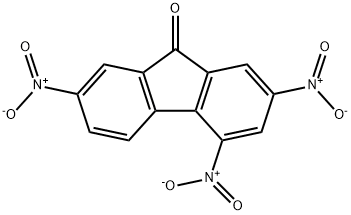2,4,7-TRINITRO-9-FLUORENONE
Synonym(s):TNF-a;TNF-α;Cachectin;mTNF-α;Tumor necrosis factor
- CAS NO.:129-79-3
- Empirical Formula: C13H5N3O7
- Molecular Weight: 315.19
- MDL number: MFCD00001142
- EINECS: 204-965-0
- SAFETY DATA SHEET (SDS)
- Update Date: 2024-12-18 14:15:32

What is 2,4,7-TRINITRO-9-FLUORENONE?
The Uses of 2,4,7-TRINITRO-9-FLUORENONE
Tumor Necrosis Factor-α from mouse, a potent proinflammatory cytokine has been used:
- to activate MS1 endothelium cells
- to induce lipolysis in adipocytes
- to study its effect on liganded and unliganded glucocorticoid receptor (GR) in interleukin (IL)-6 and IL-8 gene regulation
The Uses of 2,4,7-TRINITRO-9-FLUORENONE
TNF-α influences the growth and function of both normal and neoplastic cells. TNF-α causes cytolysis or cytostasis of certain transformed cells being synergistic with γ-interferon in its cytotoxicity.
General Description
Pale yellow needles (from acetic acid or benzene) or yellow powder.
Air & Water Reactions
Insoluble in water.
Reactivity Profile
Literature sources indicate that 2,4,7-TRINITRO-9-FLUORENONE is flammable. . Aromatic nitrates range from slight to strong oxidizing agents. If mixed with reducing agents, including hydrides, sulfides and nitrides, they may begin a vigorous reaction.
Hazard
Suspected carcinogen. Mildly toxic by ingestion. A skin and eye irritant.
Fire Hazard
Literature sources indicate that 2,4,7-TRINITRO-9-FLUORENONE is flammable.
Biochem/physiol Actions
The TNFA (tumor necrosis factor α) gene is significantly associated with the regulation of innate and adaptive immune responses. Polymorphism of TNFA gene is known to cause acute motor axonal neuropathy. The cytokine release and gene action is associated with epithelial cells, myeloid cells, endothelial, as well as tumor cells. Tumor cells are known to release TNFA, specifically in response to chemotherapy
Safety Profile
Suspected carcinogen with experimental tumorigenic data. Mildly toxic by ingestion. Human mutation data reported. A skin and eye irritant. When heated to decomposition it emits hghly toxic fumes of NOx. See also NITRO COMPOUNDS of AROMATIC HYDROCARBONS and KETONES.
Purification Methods
Crystallise it from nitric acid/water (3:1), wash it with water and dry it under vacuum over P2O5, or recrystallise it from dry *benzene. [Beilstein 7 II 410, 7 III 2348, 7 IV 1638.]
Properties of 2,4,7-TRINITRO-9-FLUORENONE
| Melting point: | 176-178°C |
| Boiling point: | 454.77°C (rough estimate) |
| Density | 1.5148 (rough estimate) |
| refractive index | 1.5600 (estimate) |
| storage temp. | -20°C |
| form | powder |
| color | white |
| CAS DataBase Reference | 129-79-3(CAS DataBase Reference) |
| EPA Substance Registry System | 2,4,7-Trinitrofluoren-9-one (129-79-3) |
Safety information for 2,4,7-TRINITRO-9-FLUORENONE
| Signal word | Warning |
| Pictogram(s) |
 Exclamation Mark Irritant GHS07 |
| GHS Hazard Statements |
H315:Skin corrosion/irritation H319:Serious eye damage/eye irritation |
| Precautionary Statement Codes |
P264:Wash hands thoroughly after handling. P264:Wash skin thouroughly after handling. P280:Wear protective gloves/protective clothing/eye protection/face protection. P302+P352:IF ON SKIN: wash with plenty of soap and water. P305+P351+P338:IF IN EYES: Rinse cautiously with water for several minutes. Remove contact lenses, if present and easy to do. Continuerinsing. P332+P313:IF SKIN irritation occurs: Get medical advice/attention. P337+P313:IF eye irritation persists: Get medical advice/attention. |
Computed Descriptors for 2,4,7-TRINITRO-9-FLUORENONE
New Products
(S)-3-Aminobutanenitrile hydrochloride 4-Methylphenylacetic acid N-Boc-D-alaninol N-BOC-D/L-ALANINOL Tert-butyl bis(2-chloroethyl)carbamate 3-Morpholino-1-(4-nitrophenyl)-5,6-dihydropyridin- 2(1H)-one Furan-2,5-Dicarboxylic Acid Tropic acid 1-Bromo-3,5-Di-Tert-Butylbenzene S-2-CHLORO PROPIONIC ACID ETHYL ISOCYANOACETATE 2-Bromo-1,3-Bis(Dimethylamino)Trimethinium Hexafluorophosphate 4-IODO BENZOIC ACID 3-NITRO-2-METHYL ANILINE 1-(2,4-DICHLOROPHENYL) ETHANAMINE (2-Hydroxyphenyl)acetonitrile 4-Bromopyrazole 2-(Cyanocyclohexyl)acetic acid 4-methoxy-3,5-dinitropyridine 1-(4-(aminomethyl)benzyl)urea hydrochloride 2-aminopropyl benzoate hydrochloride diethyl 2-(2-((tertbutoxycarbonyl)amino) ethyl)malonate tert-butyl 4- (ureidomethyl)benzylcarbamate Ethyl-2-chloro((4-methoxyphenyl)hydrazono)acetateRelated products of tetrahydrofuran








You may like
-
 Anti-TNFA antibody produced in rabbit CASView Details
Anti-TNFA antibody produced in rabbit CASView Details -
 Tumor Necrosis Factor-α from mouse CASView Details
Tumor Necrosis Factor-α from mouse CASView Details -
 Tumor Necrosis Factor-α from rat CASView Details
Tumor Necrosis Factor-α from rat CASView Details -
 1975-50-4 98%View Details
1975-50-4 98%View Details
1975-50-4 -
 2-HYDROXY BENZYL ALCOHOL 98%View Details
2-HYDROXY BENZYL ALCOHOL 98%View Details
90-01-7 -
 2-Chloro-1,3-Bis(Dimethylamino)Trimethinium Hexafluorophosphate 221615-75-4 98%View Details
2-Chloro-1,3-Bis(Dimethylamino)Trimethinium Hexafluorophosphate 221615-75-4 98%View Details
221615-75-4 -
 14714-50-2 (2-Hydroxyphenyl)acetonitrile 98+View Details
14714-50-2 (2-Hydroxyphenyl)acetonitrile 98+View Details
14714-50-2 -
 118753-70-1 98+View Details
118753-70-1 98+View Details
118753-70-1